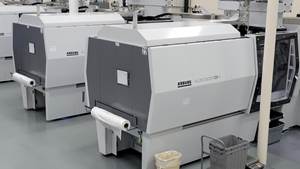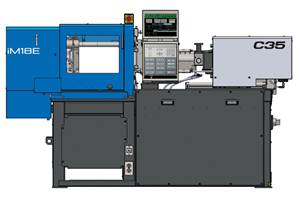Novel Two-Stage Approach Makes Purging Hot Runners a Breeze
Two new and unusual compounds have been developed to ease the challenge of purging injection molding hot-runner systems.
Two new and unusual compounds have been developed to ease the challenge of purging injection molding hot-runner systems. The long residence time of melt in these systems often leads to troublesome deposits of degraded material. These deposits can be hard to dislodge and tend to shed black specks.
One of the new compounds is used at start-up ofa new resin or color. It coats the melt channel, forming a barrier that insulates the resin being molded from excessive heat exposure. It is easy to purge from the system, so it acts more like a release coating for the resin being molded than an actual purging agent.
The other new product is a purging agent that acts by a novel process of “molecular cavitation,” which is said to clean the screw and hot runner safely and more effectively than standard purging materials.
These products are sold under the Cel-Span brand name by Phoenix Plastics, a custom compounder and supplier of specialty additive masterbatches. They were co-developed together with Stabilization Technologies, a consulting firm in Charlotte, N.C, headed by Joseph R. Webster, a well-known expert in additive chemistry for plastics and fibers. According to Webster, such a two-pronged approach provides the best control of black specks and cross-contamination between materials and colors in molded parts.
Both products are typically offered in non-wax polyolefin carriers for resins processed in the 350 to 575 F range, including polyolefins, styrenics, TPOs, TPEs, and TPUs. Custom carriers are offered for other materials, such as glass-filled nylon.
Release coating & heat barrier
Webster describes Cel-Span 310 as an “interfacial resin barrier compound” that is designed for use at start-up to protect the plastic from thermal-oxidative breakdown in hot-runner channels. Containing a proprietary stabilizer system, it functions as a durable release coating that builds up into a heat-stable barrier between the tooling metal and the plastic being molded. Says Webster, “Starting up with 310 after a major hot-runner mold cleanup will establish a thermally stable cap and coat the metal with a heat-stable polymer. It is the key to extended stabilization and prevention of black specks and crossover contamination.”
When it comes time to change colors or resins, Cel-Span 310 is easily expelled with a purging compound, such as Webster’s other new product.
Novel transition purge
Cel-Span 399 transition purging compound functions as both a chemical and physical purging agent in hot-runner systems with frequent resin or color changes. It contains a proprietary inorganic, non-abrasive, nitrogen-based chemical foaming agent. It is non-acidic and non-corrosive and produces no acidic byproducts that can interact with the mold or materials being molded. As with other chemical purging agents, it also contains detergents and a thermal-oxidative stabilizer system.
Although initiated by chemical foaming, the compound’s physical purging action is accomplished by microscopic gas bubbles. The bubbles expand and condense into a liquid that solvates and softens de-graded resins and remnants of the previous color or material. In what Webster calls molecular cavitation, the bubbles expand and contract and work their way under degraded material that has adhered to the screw and/or hot runner.
“When the cavitation is at its best, the cycle of gas to liquid to gas is resonant and acts to remove by solvation all remnants of the material on the screw and hot-runner wall. This physical purging action, in combination with the chemical action of the other ingredients, prevents viscosity drop while maintaining the oxidative integrity of the plastic over time,” says Webster.
Related Content
Consistent Shots for Consistent Shots
An integral supplier in the effort to fast-track COVID-19 vaccine deployment, Retractable Technologies turned to Arburg and its PressurePilot technology to help deliver more than 500 million syringes during the pandemic.
Read MoreScaling New Heights With Vertical Integration
Eden Manufacturing was founded on a vision of vertical integration, adding advanced injection molding capabilities to a base of precision moldmaking and more recently bringing Swiss-type machining capabilities in-house.
Read MoreCompact Hybrid Injection Molding Machine Launched
Sumitomo Heavy Industries Ltd. (SHI) has introduced the iM18E, promising the smallest footprint in 20-ton machines.
Read MoreAll-Electric Injection Molding Machine Line Expands
Fakuma 2024: Engel unveils new e-mac 500 with “High” clamping drive and encapsulated toggle-lever mechanism.
Read MoreRead Next
Making the Circular Economy a Reality
Driven by brand owner demands and new worldwide legislation, the entire supply chain is working toward the shift to circularity, with some evidence the circular economy has already begun.
Read MoreSee Recyclers Close the Loop on Trade Show Production Scrap at NPE2024
A collaboration between show organizer PLASTICS, recycler CPR and size reduction experts WEIMA and Conair recovered and recycled all production scrap at NPE2024.
Read MoreBeyond Prototypes: 8 Ways the Plastics Industry Is Using 3D Printing
Plastics processors are finding applications for 3D printing around the plant and across the supply chain. Here are 8 examples to look for at NPE2024.
Read More






















